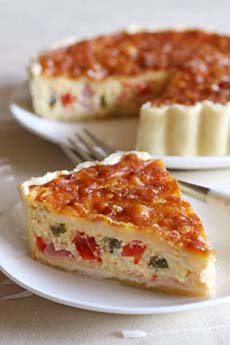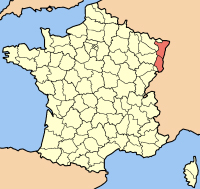
 This cheese quiche, with its red and green accents, is pretty for the holidays—or the other 11 months of the year. Photo courtesy UmamiInfo.com. This cheese quiche, with its red and green accents, is pretty for the holidays—or the other 11 months of the year. Photo courtesy UmamiInfo.com.
November 2007
Last Updated May 2014
|
 |
Cheese Quiche Recipe
A Quiche With A Fall & Holiday Filling
This is Page 1 of a two-page article. Click on the black link below to visit Page 2.
Quiche & Flan
Take a look at the inside of this lovely quiche. The bright red and green remind one of leaves of fall, or the red and green colors of the holiday season. Quiche can be served at brunch, lunch or dinner, and mini-quiches can be served as cocktail hors d’oeuvres. Recipes can be varied easily to make them vegetarian, to include shrimp—whatever the occasion calls for.
This recipe was originally titled “Cheese Flan.” The words quiche and flan can be used interchangeably. Flan, the Spanish word for a type of custard, is used by the British to describe a sweet or savory custard tart (and other types of custard dishes); whereas quiche is the French word for a savory custard tart. (See our Custard Glossary for the many different kinds of custard dishes.)
The History Of Quiche
The word quiche evolved from the German word Küchen, cake. The dish originated in Alsace-Lorraine (hence, Quiche Lorraine, a specific recipe that uses heavy cream and bacon—no cheese). Alsace-Lorraine, now a region of northeastern France, borders on Germany and over the centuries was variously in German control. According to food historians, when the quiche—now considered a quintessential French dish—was developed, the region was a German province called Lothringen.
It’s easy to remember the three points of similarity/difference between quiche and flan:
- Similar: Both have a custard base and are baked in a buttery pâté brisée (also known as a short paste or shortcrust pastry), a proportion of five parts flour to four parts butter. Sweet flans are baked in a sweet pâté brisée, or pâté brisée sucrée.
|
|

Map of France highlighting Alsace-Lorraine in red. On the eastern border of France are, from north to south, Belgium, Luxembourg, Germany, Switzerland and Italy. To the south is Spain, to the north across the English Channel is England. Image courtesy Wikimedia. |
- Different: Flans can be sweet as well as savory (berries in a custard base, for example), while quiche is always savory.
Whether you want to call this savory recipe quiche or flan, cream and eggs are needed to make the custard, and a pastry shell is required. (See our Custard Glossary for the different types of custard.) Then, any variety of ingredients may be added:
- Gruyère (a specific type of Swiss cheese), Roquefort or Camembert cheeses;
- Niçoise (tomato, anchovy and olives)
- Fruits de Mer (crab, lobster and/or shrimp)
- Meats including bacon, ham and sausage
- Vegetables such as endive, leeks, onions, mushrooms and spinach.
As with pizza toppings, one can create the quiche or flan of one’s dreams.
In France, quiche is served for luncheon or a light supper, along with a salad, bread and white wine. Or, it can be the first course for a more elaborate dinner.
Continue To Page 2: Cheese Quiche Recipe
Go To The Article Index Above
Recipe © Copyright Umami Information Bureau, UmamiInfo.com. Other material
Lifestyle Direct, Inc. All rights reserved. Photo courtesy of Umami Information Bureau. Images are the copyright of their respective owners.

|





